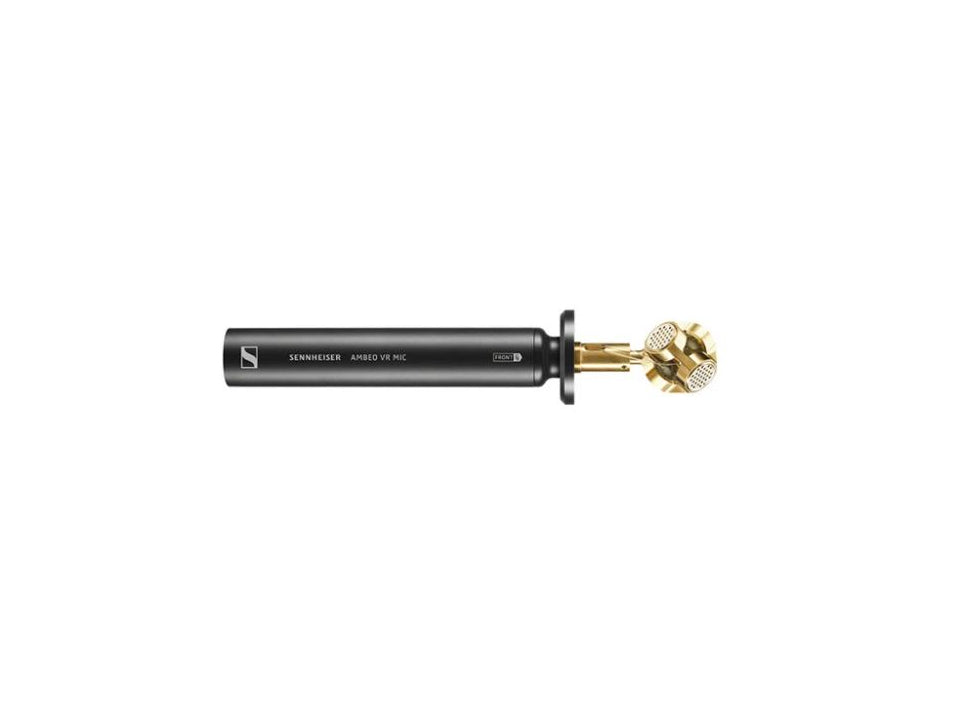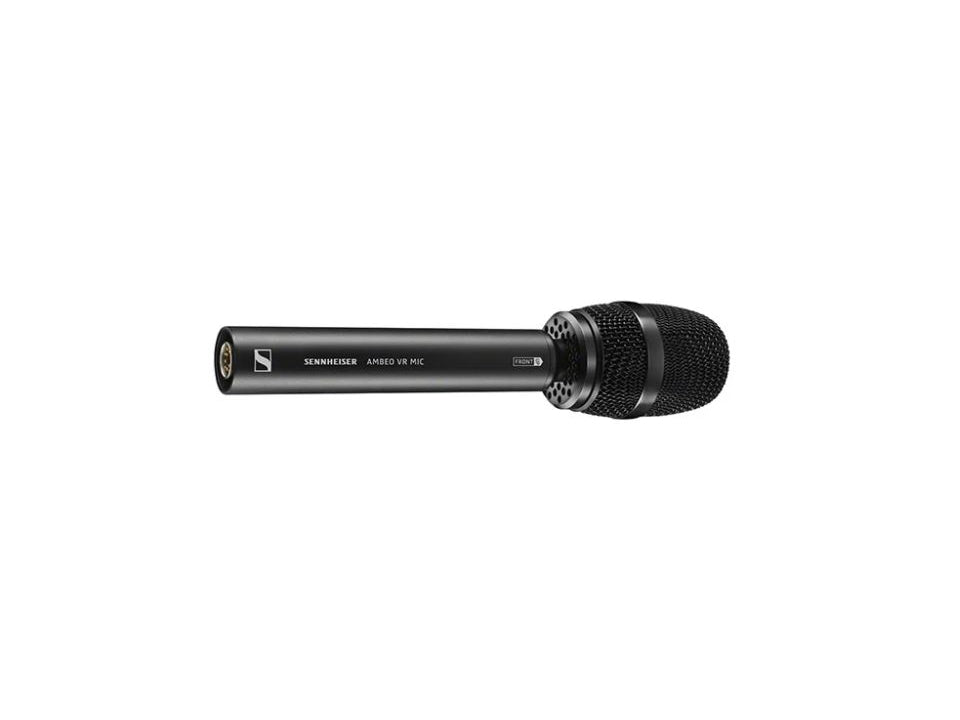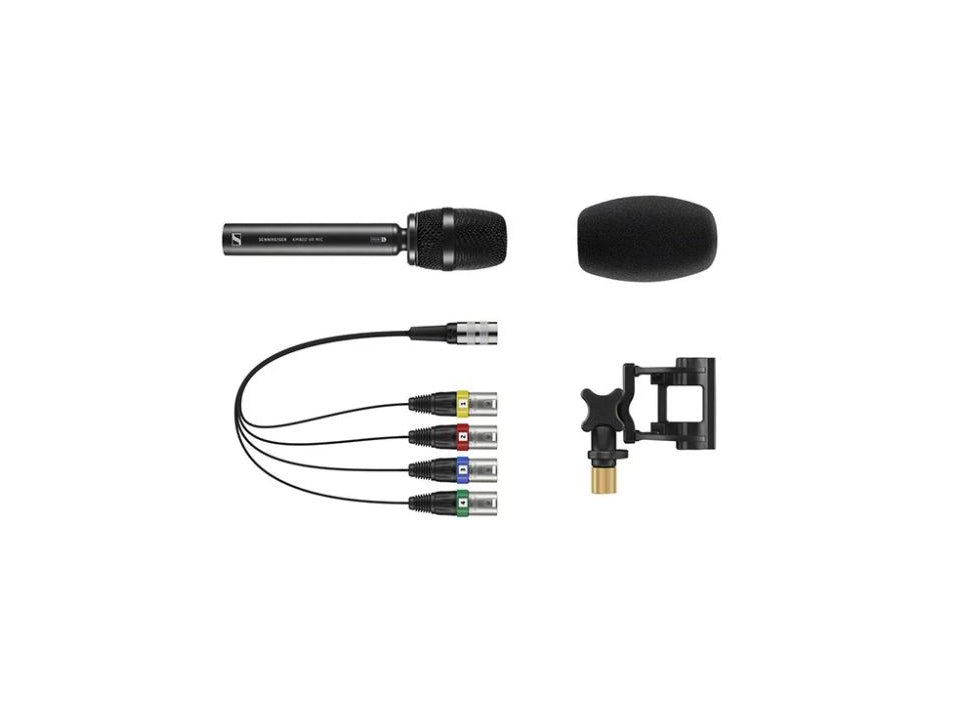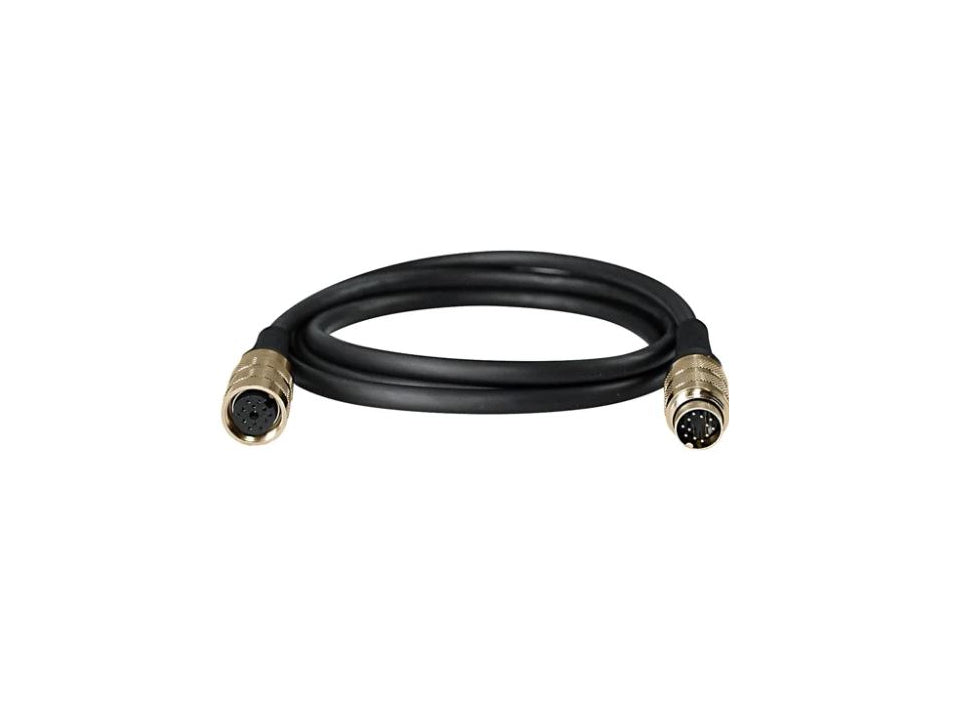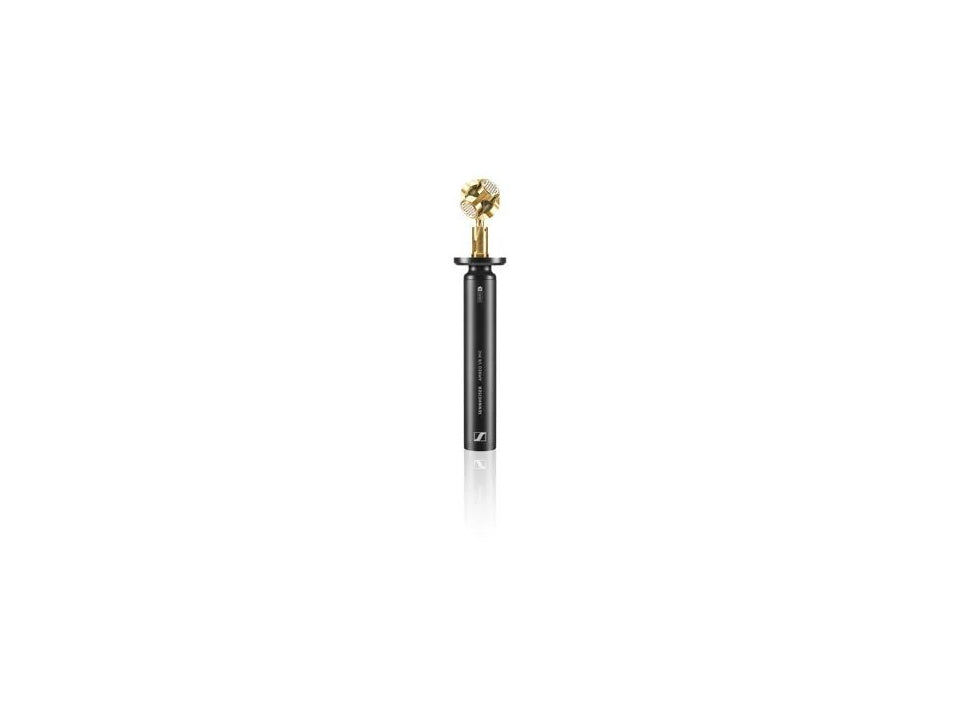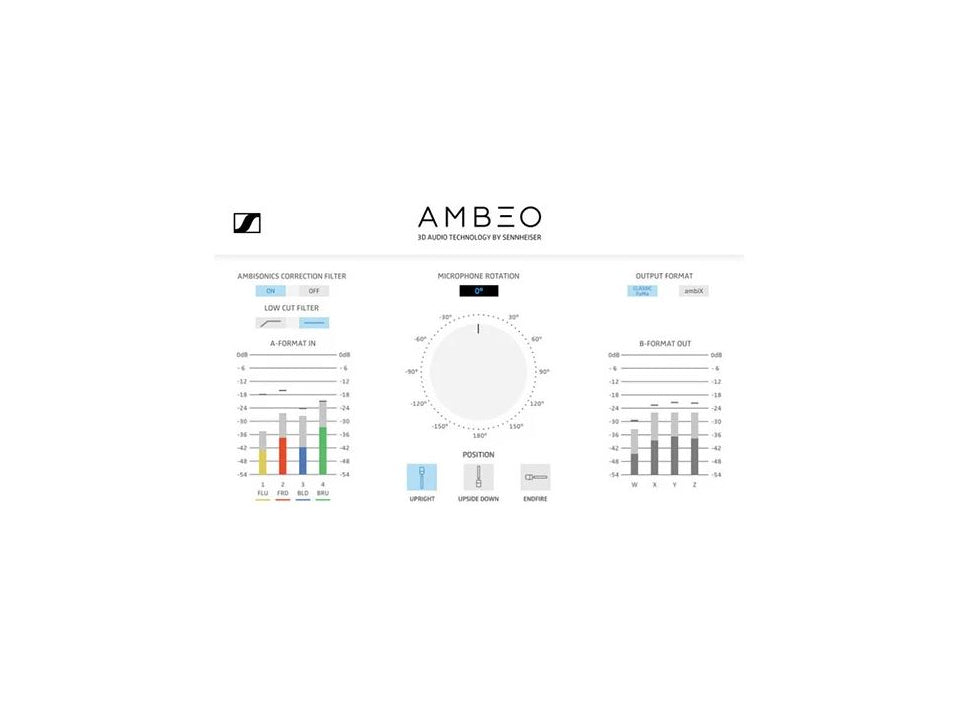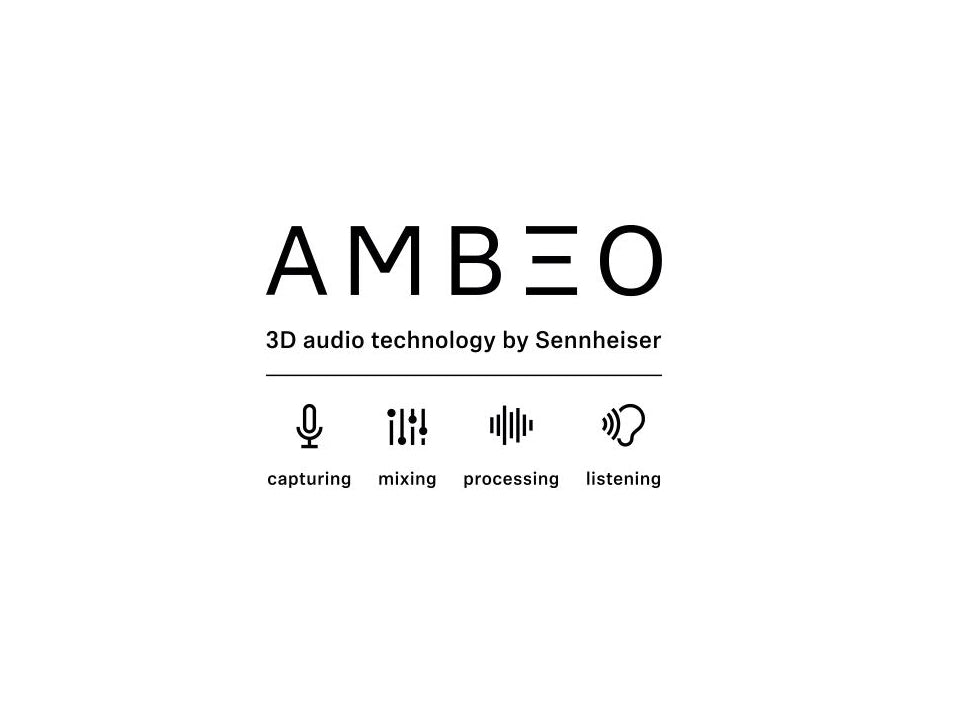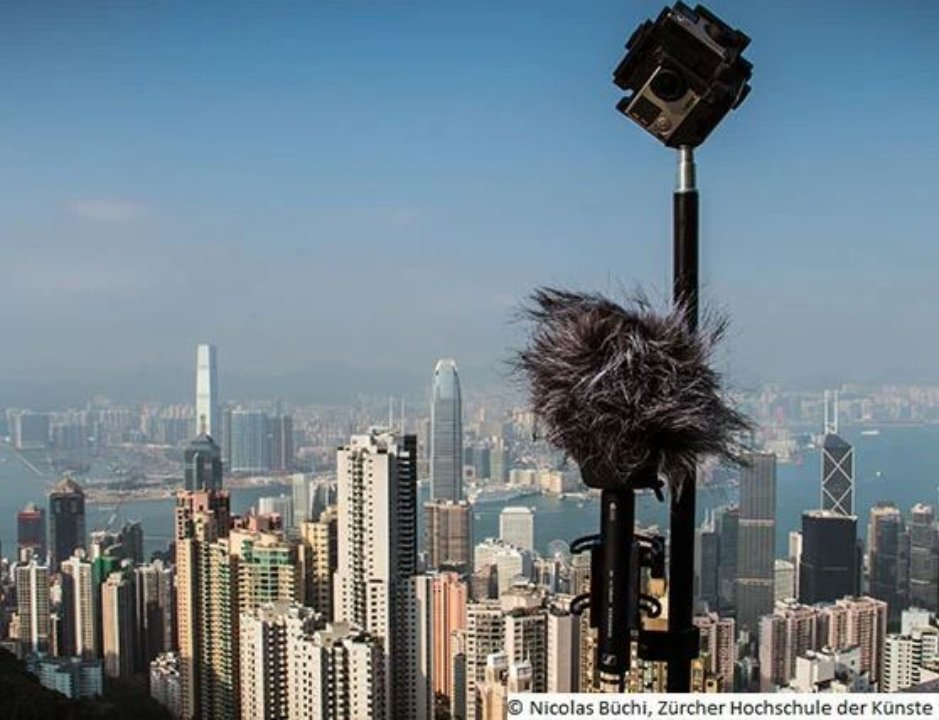Sennheiser
AMBEO VR Mic - Ambeo® Ambisonics Microphone
AMBEO VR Mic - Ambeo® Ambisonics Microphone
excl. VAT
Ready to ship in 3-5 days
Item number: A08162
Couldn't load pickup availability
Convey the true experience
Especially designed for 360° spatial audio recording, the easy-to-use AMBEO VR Mic is an ambisonic microphone fitted with four matched KE 14 capsules in a tetrahedral arrangement. This special design allows you to capture the surrounding sound from one single point. As a result you get fully spherical ambisonics sound to match your VR video/spherical 360 content.
A jewel in your high-end VR sound chain
The AMBEO VR Mic is meant to work together with specialized high-end software and hardware. Ideal companions for the AMBEO VR Mic are, for example, field recorders like the Zoom F8, digital audio workstations like the Avid Pro Tools HD or the Cockos Reaper and binaural decoders e. g. from Noise Makers. Output is possible via HMD, VR Game Engine or 360° Social Media platforms.
Benefit from a design developed with you in mind
By means of the VR Creators Program Sennheiser made sure to involve the professionals of the industry in the realization of the AMBEO VR Mic right from the beginning. Thus, we developed a comprehensive product package including many well-conceived accessories that allow for a smooth workflow – not least the A-B encoder software that works as a plugin, which can be seamless embedded in your post-production process.
Ambisonics – Technology for you to shape the future of audio
Ambisonics is a multi-channel technology that lets you spherically capture the sound arriving from all directions, at a single point in space. For playback this representation is rendered binaurally, allowing you to virtually rotate the orientation of the perspective in all directions, horizontally and vertically.
Ambisonics is supported by all of the major post-production and playback tools on the market today. This makes ambisonics the appropriate tool for Virtual Reality and all other applications involving 3D sound. A tool to create new worlds of sound with.
AMBEO A-B converter plugin
The capsules of the Sennheiser AMBEO VR Mic deliver A-format, a raw 4-channel output that has to be converted into a new set of 4 channels, the Ambisonics B-format. This is done by the specifically designed Sennheiser AMBEO A-B converter plugin, which is available as free download for VST, AU and AAX format for your preferred Digital Audio Workstation for both PC and Mac. B-format is a W, X, Y, Z representation of the sound field around the microphone. W being the sum of all 4 capsules, whereas X, Y and Z are three virtual bi-directional microphone patterns representing front/back, left/right and up/down. Thus, any direction from the microphone can be auditioned by the listener during playback of Ambisonics B.
Enjoy peace of mind with Sennheiser quality
With its history of 70 years as a trusted and innovative company, developing top-notch professional microphones with high-quality capsules, you are entitled to expect a lot from the Sennheiser brand: reliable, robust German-engineered products. Rest assured: We deliver – and also provide excellent customer support as well as a 2-years warranty with every product.AMBEO VR Mic
Tutorial videos for 360° and VR: Recording, Processing, Mixing, Delivering
- The Principle https://youtu.be/bLfQb8isuQo
- Recording https://youtu.be/45RVqfHWHBc
- VR Field Recording https://youtu.be/LG7rTTyr84g
- Processing https://youtu.be/hCDVDyYmouk
- Mixing https://youtu.be/MNq4iU3ip9k
- Delivering https://youtu.be/VNgVYmk0IeY
Try a sample Reaper session and get started with AMBEO for VR
If you are interested in getting familiar with the production workflow, start here.
AMBEO Blueprints
The AMBEO Blueprints provide a quick guide to recording and mixing live music to deliver a 3D audio experience on headphones or loudspeakers. Producing immersive content is a new and growing craft.
https://en-us.sennheiser.com/ambeo
What's in the box?
- AMBEO VR Mic
- Balanced split cable 4x XLRs 3-pins
- Extension cable, 1.5m, DIN12F to DIN12M
- Rycote suspension mount
- Foam wind shield
- Proprietary A-B encoder, available in VST plugins (Mac OS X and Windows) and AAX plugins (Mac OS X)
FAQ
What is Immersive Audio, 3D audio?
For many years, people have spoken about Surround Sound. With Immersive Audio, we speak about an additional dimension, namely the height dimension. We expect this to be the future of audio technology, comparable with the evolution from mono to stereo.
In addition to the known Surround-placement (ear level/surround layer) we use elevation layers to place the audio elements in a 3-dimensional environment enveloping the listener.
What does “AMBEO” mean?
AMBEO is Sennheiser’s program and trademark for 3D audio, which will cover immersive audio products and technologies for the entire audio signal chain, from capture to mixing and processing to reproduction.
AMBEO products will be designed to deliver immersive sound experiences with an incredibly high emotional impact. While stereo audio or even 5.1 or 7.1 formats reproduce sound in a “plane”, AMBEO introduces a height elevation that creates an “as if there” feeling. This sound revelation has been compared to the switch from mono to stereo that happened in the last century. AMBEO 3D audio is so realistic that it is set to eliminate the boundaries between reality and playback, and between real and artificial sound sources.
By revealing its strategic focus on 3D audio from very early on, Sennheiser has made AMBEO an invitation to users and technology partners around the globe to include their ideas, feedback and requirements in the design of the company’s 3D audio solutions, thus shaping the future of audio together with Sennheiser.
AMBEO will set standards in immersive audio, creating a totally new audio experience that will change music and sound forever. Thanks to Sennheiser’s broad audio expertise and product offering, application scenarios will reach from music recording, filming and 3D audio installations in venues to gaming, sports broadcasting and playback on personal devices.
How is AMBEO different from other audio formats?
AMBEO products will be designed to deliver immersive sound experiences with an incredibly high emotional impact. While stereo audio or even 5.1 or 7.1 formats reproduce sound in a “plane”, AMBEO introduces a height elevation that creates an “as if there” feeling in 9.1. This sound revelation has been compared to the switch from mono to stereo that happened in the last century. AMBEO 3D audio is so realistic that it is set to eliminate the boundaries between reality and playback, and between real and artificial sound sources.
What will be possible uses/applications for the AMBEO VR Mic?
The unobtrusive, flexible and easy to use microphone was specially designed with Virtual Reality content producers in mind. Giving experienced sound designers as well as newcomers to 3D Audio the chance to record environment sounds by capturing 4 quadrants in high-quality standards, Sennheiser’s VR microphone is going to be a stable tool in any VR production.
The innovative 3D microphone will be an important tool for VR productions and has been designed in cooperation with VR content producers and fine-tuned in an extensive creators’ program with participants from across the VR audio/video industry – and from across the globe. The microphone uses four cardioid condenser capsules in a tetrahedral arrangement; its signals are converted to B-format files in digital audio workstations by the supplied encoding software. The A-B-converter will be available as VST, AU and AAX plug-ins for Mac or Windows.
How is the AMBEO VR Mic set-up in proper use?
Microphone to be used in parallel with VR cameras for full VR experience.
Why does the AMBEO VR Mic have four capsules?
The four capsules are arranged in a tetrahedral cluster. This permits the capture of sound from all directions and provides what is called Ambisonics A-Format.
What is the output of the AMBEO VR Mic?
The AMBEO VR mic outputs 4 x audio signals (one for each capsule) via a multipin connector at the base of the microphone. A special cable then splits the individual audio channels into 4 x Standard XLR 3F connectors identified numerically and by color.
Does the AMBEO VR Mic need phantom power?
Yes, the AMBEO VR mic requires 4x 48v Phantom power (each capsule is a separate channel).
What is Ambisonics and why is it relevant to VR?
The Sennheiser AMBEO VR Mic works in Ambisonics. Ambisonics captures audio in full-sphere surround from a single point in space. Not only horizontally, but also smoothly covering sound above and below. Developed in the 1970’s and mostly used for music recording, Ambisonics does not have outputs corresponding to speakers, but consists of a speaker independent representation of the sound field called B-format. This allows us to virtually rotate the orientation of the microphone in all directions and to position sound sources independently from speaker positions.
B-format can be decoded to existing speaker layouts or binaurally rendered (using HRTF) to headphones.
B-format representation can be changed dynamically by the use of head-tracking headphones or gyros in smartphones – this will make the audio spin when experiencing 360°videos.
What are the main use cases?
- Cinematic Virtual Reality
- Linear action based virtual reality
- Capture of live action as in traditional film
- Capture of ambiances for VR Games and other interactive Virtual Reality content
- Capture of sound beds for game sound design
- Livestreamed VR content
- Livestreamed content focused on sports or current events
Where do I place the microphone?
The 3D sound field is captured spherically from the point in the sound field the AMBEO VR Mic is positioned. When used together with a 360° camera rig, the AMBEO VR Mic should be mounted as coincident as possible with it. Align the “Front” marking on the AMBEO VR Mic with the intended front of the camera.
How do I process and listen to Ambisonics sound format?
The AMBEO VR Mic delivers first order Ambisonics A-format, which needs to be converted into B-format. This conversion is a crucial part of the functionality and sound of the microphone. You will need to download and install the Sennheiser AMBEO A-B converter (link below) and load it into a 4-channel strip in your preferred Digital Audio Workstation. Ambisonics can be decoded into 3D Binaural Stereo with e.g. NoiseMakers AmbiHead plug-in.
What is the difference between the output standards and which one should I choose?
On the output of the AMBEO A-B converter you can choose between “Classic FuMa” and “ambiX”. The differences are in the Ambisonics channel ordering and levels. Which one to choose is dependent on the workflow and possibly other signals and/or tools in ambisonics, which all need to be in the same format. For upload to YouTube 360, always choose “ambiX” to be compliant with the spatial audio processing done in the browser.
How can I use the A-B converter in Logic Pro X?
Set up an LCRS or quadrophonic surround track in Logic.
Go to Preferences → Advanced Tools → Show Advanced Tools and enable Surround.
Then go to File → Project Settings → Surround Format and select either LCRS or Surround.
Finally create a surround track by selecting Track → New Tracks → Audio and select Surround for both in- and output.
The plugin should now be available as Audio Unit on this track.
